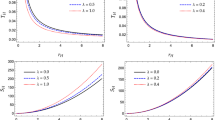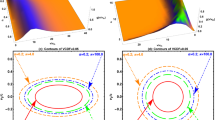Abstract
The Hawking effect of a nonuniformly rectilinearly accelerating Kinnersley black hole is studied. Its horizons are rotationally symmetric. Its Hawking temperature depends not only on the time, but also on the polar angle. When a Kinnersley black hole touches its Rindler horizon, the Hawking temperature at the contact point is reduced to zero. But at the opposite pole of the black hole, the Hawking temperature increases rapidly. A jet appears as a tail of the accelerating black hole.
Similar content being viewed by others
References
Balbinot, R. (1986).Physical Review D,33, 1611.
Damour, T., and Ruffini, R. (1976).Physical Review D,14, 332.
Hiscock, W. A. (1981).Physical Review D,23, 2813, 2823.
Kinnersley, W. (1969).Physical Review,186, 1335.
Sannan, S. (1988).General Relativity and Gravitation,20, 239.
Unruh, W. G. (1976).Physical Review D,14, 870.
Zhao Zheng and Dai Xianxin (1992).Modern Physics Letters A,7, 1771.
Zhao Zheng and Li Zhong-heng (1993).Nuovo Cimento B,108, 785.
Zhao Zheng, Yang Cheng-quan, and Ren Qin-an (1994).General Relativity and Gravitation,26, 1055.
Zhu Jian-yang, Bao Ai-dong, and Zhao Zheng (1995).International Journal of Theoretical Physics,34, 2049.
Author information
Authors and Affiliations
Rights and permissions
About this article
Cite this article
Zheng, Z., Jian-hua, Z. & Ya-ling, J. A jet appearing when a black hole event horizon touches the rindler horizon. Int J Theor Phys 36, 1359–1368 (1997). https://doi.org/10.1007/BF02435929
Received:
Issue Date:
DOI: https://doi.org/10.1007/BF02435929




